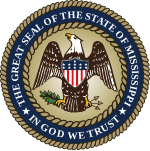| | |||||||||||||||||
| |||||||||||||||||
| |||||||||||||||||
Bilbo: 30-40% 40-50% 50-60% 60-70% 70-80% 80-90% 100% Murphree: 30-40% 40-50% 50-60% 60-70% Anderson: 40-50% 50-60% 70-80% Conner: 30-40% 40-50% | |||||||||||||||||
| |||||||||||||||||
| Elections in Mississippi |
|---|
 |
The 1927 Mississippi gubernatorial election took place on November 8, 1927, in order to elect the Governor of Mississippi. Incumbent Democrat Dennis Murphree, as he had not served a full term, was eligible for and ran for election. As was common at the time, the Democratic candidate ran unopposed in the general election; therefore the Democratic primary was the real contest, and winning the primary was considered tantamount to election.




